Professional gemologists use ten sophisticated techniques you can’t replicate at home: refractive index measurement with advanced refractometers, spectroscopic analysis for chemical fingerprinting, inclusion mapping through high-powered magnification, precise carat weight assessment using certified digital scales, standardized color grading systems, fluorescence response testing under UV light, Mohs scale hardness protocols, geographic origin authentication, treatment detection via thermal analysis, and density measurement techniques. These scientific methods guarantee accurate valuations that protect both buyers and sellers in today’s competitive market, and understanding their applications will transform your gemstone expertise.
Refractive Index Measurement Using Advanced Refractometers
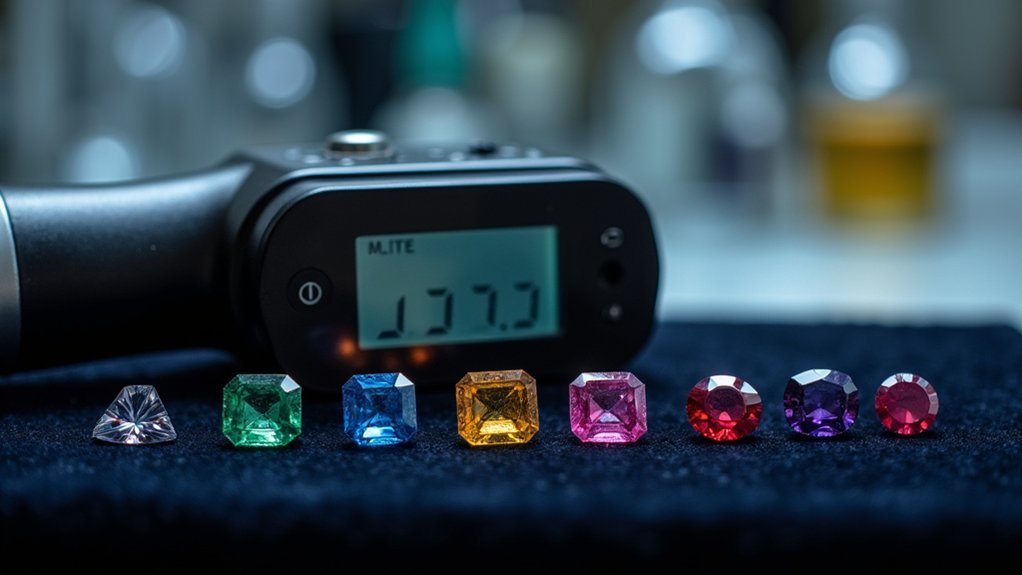
Precision drives gemstone identification, and advanced refractometers serve as your primary tool for measuring how light bends through different materials.
You’ll use these instruments to determine a gemstone’s refractive index, which directly impacts brilliance and fire. Higher values create greater light refraction, enhancing visual appeal and increasing valuation potential.
As a gemologist, you’ll rely on specific refractive index ranges to differentiate similar-looking stones and authenticate their identities. Your refractometer’s specialized features, including temperature control and polarized light settings, guarantee measurement accuracy.
During testing, you’ll place the gemstone on the glass surface and observe the critical angle through the light source. This process allows you to calculate precise refractive index values essential for professional identification and accurate market valuation.
Spectroscopic Analysis for Chemical Composition Identification
You can identify a gemstone’s chemical composition through three primary spectroscopic methods that reveal distinct elemental signatures.
Infrared spectrum fingerprinting shows you molecular vibrations unique to each mineral, while X-ray fluorescence testing detects specific elements present in the stone’s structure.
Mass spectrometry applications allow you to analyze trace elements and isotopic ratios that help distinguish natural stones from synthetic ones and determine geographic origins.
Infrared Spectrum Fingerprinting
When you’re examining gemstones that look nearly identical to the naked eye, infrared spectrum fingerprinting cuts through the uncertainty by revealing each stone’s unique molecular signature. This non-destructive technique analyzes how infrared light interacts with molecular vibrations within your gemstone, creating distinctive absorption patterns that serve as fingerprints for identification.
| Analysis Feature | Detection Capability |
|---|---|
| Chemical Composition | Precise mineral identification |
| Synthetic Detection | Lab-created vs natural stones |
| Treatment Identification | Heat, irradiation, filling processes |
| Inclusion Analysis | Internal structure characteristics |
You’ll find this technology invaluable when valuing precious stones because it definitively distinguishes between similar-looking gems and reveals treatments affecting market worth. The spectral data enhances your confidence in authenticity and value assessments, providing the scientific foundation needed for accurate gemstone grading.
X-Ray Fluorescence Testing
Elemental secrets hidden within gemstones reveal themselves through X-Ray Fluorescence (XRF) testing, a powerful spectroscopic technique that bombards your stones with primary X-rays to trigger characteristic secondary emissions.
You’ll discover the elemental composition of rare gems without causing any damage, as this non-destructive method detects elements from sodium to uranium with remarkable sensitivity.
The technique provides valuable information about trace elements that dramatically influence a stone’s classification and market value.
You can assess the quality and authenticity of multiple specimens rapidly, making it an efficient tool for gemological evaluation.
When you combine XRF analysis with other gemological techniques, you’ll gain extensive insights into your gemstone’s properties and provenance.
Mass Spectrometry Applications
Mass spectrometry takes gemstone analysis beyond surface-level elemental detection by measuring the mass-to-charge ratio of ionized particles from your specimens.
This advanced technique reveals trace elements and impurities that directly impact your precious stones’ monetary value and authenticity verification. You’ll detect minute quantities of elements that distinguish natural from synthetic gems, even when they share identical physical characteristics.
Mass spectrometry’s high sensitivity exposes isotopic compositions that indicate geographic origins and treatment histories.
When you’re evaluating rare varieties, this method provides definitive chemical fingerprints that other testing techniques might miss.
You can combine mass spectrometry with complementary methods like X-ray fluorescence for thorough analysis.
This integration gives you both surface and bulk composition data, ensuring accurate identification and proper valuation of your most valuable specimens.
Inclusion Mapping Through High-Powered Magnification
Using microscopes with 10x to 40x magnification, you’ll identify:
- Crystal formations, gas bubbles, and fracture patterns that indicate geological history
- Geographic origin markers through specific inclusion types and arrangements
- Clarity grades that directly impact market valuation
Advanced gemological equipment like digital imaging systems lets you create detailed inclusion maps, documenting every internal feature.
These maps become invaluable for establishing authenticity and communicating findings to clients.
Detailed inclusion maps serve as gemological fingerprints, providing irrefutable proof of authenticity and enabling clear client communication.
You’ll discover that fewer visible inclusions typically command higher prices, making precise documentation essential for accurate gemstone valuation.
Precise Carat Weight Assessment With Certified Digital Scales
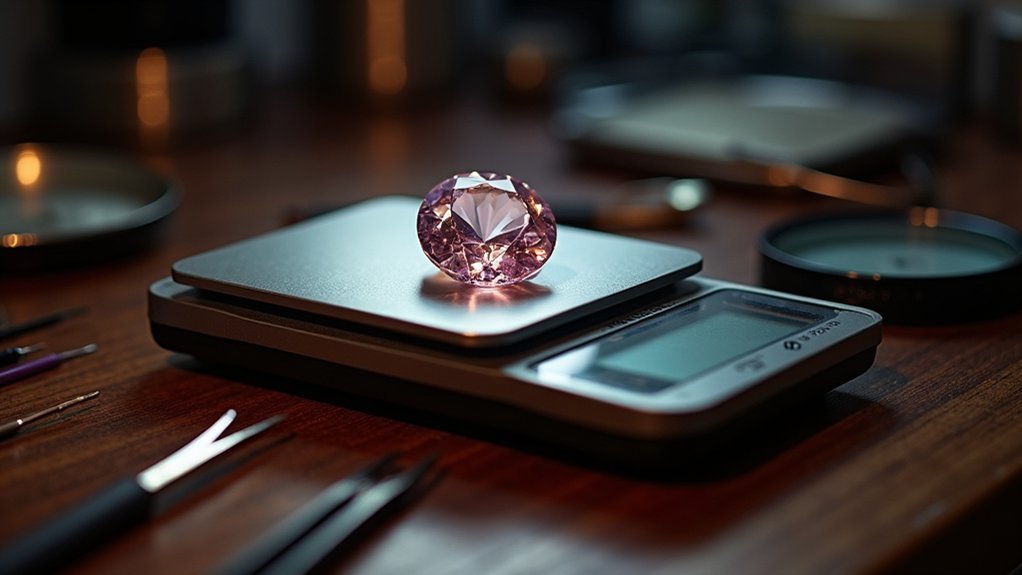
You’ll need calibrated scales that maintain consistent accuracy throughout your assessment process. The tare function eliminates container weight, guaranteeing you’re measuring only the precious stone itself. High-resolution displays help you read minute weight increments clearly.
| Feature | Benefit |
|---|---|
| Calibration against certified weights | Guarantees measurement consistency |
| Tare function | Isolates precious stone weight |
| High-resolution display | Enables clear reading of increments |
Place your scale on a stable, flat surface away from drafts. Proper technique assures reliable carat weight measurements that directly impact valuation accuracy.
Color Grading Systems for Hue, Saturation, and Tone Evaluation
Professional color grading systems break down gemstone color into three distinct components that determine market value.
You’ll need to understand how these elements work together to accurately assess any gemstone’s worth.
The three primary components you’ll evaluate include:
- Hue – the actual color identity (red, blue, green, etc.)
- Saturation – the intensity or purity of that color
- Tone – the lightness or darkness of the color
You’ll conduct evaluations under standardized lighting conditions since different light sources drastically alter color perception.
Higher saturation typically increases value, making this component essential for pricing.
Each gemstone type has ideal tone ranges – sapphires perform best at medium to medium-dark tones.
Watch for color zoning, as uneven distribution reduces value compared to consistent coloration throughout the stone.
Specific Gravity Testing for Density Verification
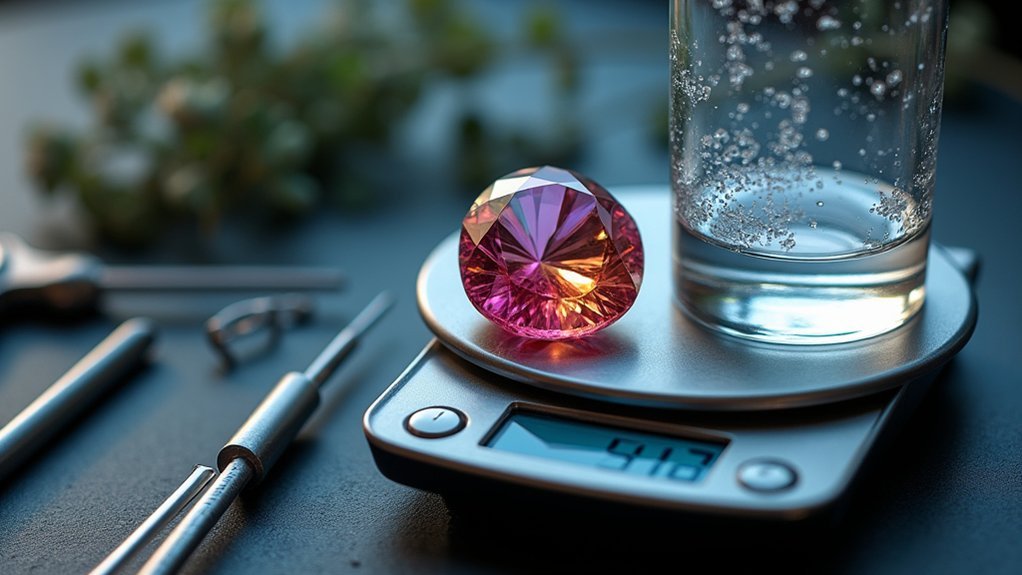
Beyond visual assessment techniques, density measurements provide objective data that confirms a gemstone’s identity and authenticity.
When you perform specific gravity testing, you’re measuring how dense your gemstone is compared to water. A skilled gemologist uses precise scales to weigh the stone in air, then submerged in water. The weight difference reveals the specific gravity—diamonds typically show 3.5, while sapphires range from 3.98 to 4.05.
You’ll need accurate measurements to distinguish between similar-looking stones, as density variations reveal material composition differences.
Professional gemologists rely on hydrometers or specific gravity kits for precise readings. These valuable insights become essential when you’re valuing rare gemstones, since authentic stones have predictable density ranges that help confirm their true identity.
Fluorescence Response Under Ultraviolet Light Sources
You’ll need to expose gemstones to both longwave and shortwave UV light sources to observe their distinct fluorescent color patterns.
These patterns can reveal whether you’re examining a natural stone or a synthetic one, as treatments and artificial origins often produce telltale fluorescence signatures.
UV Light Wavelengths
The invisible energy from ultraviolet light sources reveals hidden secrets within gemstones through fluorescence, a phenomenon where certain stones absorb UV radiation and emit visible light in response.
You’ll encounter two primary wavelengths when conducting gemstone evaluations: long-wave UV (365 nanometers) and short-wave UV (254 nanometers). Each wavelength produces different fluorescence responses in the same gemstone.
Understanding these wavelength distinctions helps you make accurate identifications:
- Long-wave UV typically produces stronger, more vibrant fluorescence colors in most gemstones.
- Short-wave UV often reveals weaker responses but can expose synthetic materials that don’t fluoresce under long-wave.
- Comparing responses between both wavelengths allows you to distinguish natural stones from treated or synthetic alternatives.
As a gemologist, you’ll use both wavelengths systematically to build a complete fluorescence profile for proper gemstone authentication and valuation.
Fluorescent Color Patterns
When you expose gemstones to ultraviolet light, they’ll reveal distinctive color patterns that serve as fingerprints for identification and authentication. Each stone’s fluorescence creates unique properties that distinguish natural gems from synthetic counterparts.
You’ll notice diamonds often display blue fluorescence that can enhance their brilliance, while rubies typically show minimal response. These patterns directly impact market value – a blue diamond’s vivid UV reaction increases desirability, whereas excessive fluorescence in colorless diamonds may reduce worth.
Using specialized equipment like long-wave and short-wave UV lamps, you’ll detect different responses that help identify treatments and lab-created stones. Understanding these fluorescent signatures enables you to authenticate gems accurately and assess their true market position.
Synthetic Detection Methods
Although synthetic gemstones can mimic their natural counterparts with remarkable precision, their fluorescence responses under UV light frequently betray their artificial origins.
You’ll find that synthetic detection methods rely heavily on fluorescence patterns that differ markedly between lab-created and natural stones.
When you examine gems under UV light, you’ll notice these key differences:
- Uniformity patterns – Synthetic gems display consistent fluorescence throughout, while natural stones show irregular responses.
- Color variations – Synthetic diamonds often fluoresce blue, whereas natural diamonds exhibit yellow, green, or no fluorescence.
- Intensity levels – Lab-created stones typically produce more predictable fluorescence intensity compared to natural gems.
As a gemologist, you’ll use UV light as your primary tool for identifying synthetic origins through these telltale fluorescence inconsistencies.
Hardness Testing Using the Mohs Scale Protocol
Since accurate gemstone identification requires precise hardness assessment, you’ll need to master the Mohs scale protocol as your primary testing method. This qualitative scale ranks minerals from 1 to 10, with talc at the bottom and diamond at the top.
As a professional gemologist, you’ll use reference minerals or specialized tools to scratch test your gemstone samples.
The testing process is straightforward: higher-ranked minerals scratch lower-ranked ones. If your gemstone scratches quartz (7), it’s harder than 7. If quartz scratches your stone, it’s softer.
Origin Authentication Through Geographic Markers
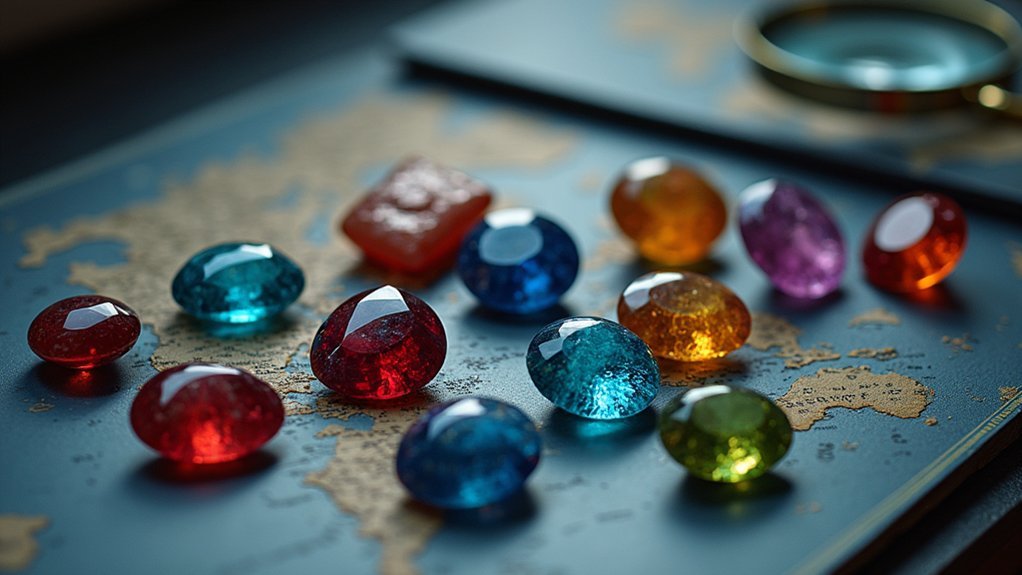
Because each geological region produces gemstones with distinctive fingerprints, you’ll find that origin authentication has become one of the most critical—and lucrative—aspects of professional gemstone valuation.
Geographic markers reveal unique characteristics that dramatically impact market value.
Geographic fingerprints determine whether your gemstone commands thousands or tens of thousands in today’s discerning marketplace.
You can identify origin through several key indicators:
- Mineral inclusions and geological formations – Colombian emeralds display distinctive three-phase inclusions that differentiate them from other sources.
- Trace element composition – Chromium levels in emeralds and iron content in sapphires pinpoint specific geographical sources.
- Advanced analytical testing – LA-ICP-MS technology provides precise elemental fingerprinting for definitive origin authentication.
Burmese rubies exemplify how origin authentication affects pricing, often commanding premium values due to their exceptional color and provenance.
You’ll discover that mastering these geographic markers transforms your valuation accuracy and professional credibility.
Treatment Detection via Thermal and Chemical Analysis
You’ll need sophisticated analytical methods to detect whether a gemstone has undergone treatment processes that affect its value.
Thermal analysis techniques like thermoluminescence can reveal heat treatments by measuring how stones respond to controlled temperature changes, while chemical methods such as X-ray fluorescence identify elements introduced during enhancement procedures.
These detection methods help you distinguish between natural characteristics and artificial modifications, ensuring accurate valuation of treated versus untreated specimens.
Thermal Heat Treatment Detection
When evaluating gemstones for accurate valuation, you’ll need to identify whether thermal treatments have been applied to enhance their color and clarity.
Since untreated stones command markedly higher prices in the gemstone market, detecting thermal treatment becomes essential for accurate assessment.
You can employ several advanced detection methods:
- Thermal imaging analysis – Examine thermal conductivity patterns that reveal heat treatment signatures
- Differential thermal analysis (DTA) – Identify specific heat changes indicating alterations in chemical structure
- Fourier-transform infrared spectroscopy (FTIR) – Detect treatment-related chemical compounds through chemical analysis
These techniques help you distinguish between natural and thermally enhanced stones.
Chemical Enhancement Analysis Methods
Chemical enhancement analysis methods provide sophisticated tools for detecting artificial treatments that markedly impact gemstone valuation.
You’ll use Fourier Transform Infrared Spectroscopy (FTIR) and Raman spectroscopy to identify specific chemical compounds indicating treatment history. These techniques reveal anomalies in crystalline structure and elemental composition that treatments introduce.
When you perform chemical enhancement analysis, you’re examining molecular fingerprints that distinguish natural stones from treated ones. FTIR detects vibrational frequencies of chemical bonds, while Raman spectroscopy identifies structural changes caused by irradiation or heat enhancement.
You’ll find this analysis essential for accurate gemstone valuation since treated stones typically command considerably lower market value than untreated counterparts.
These methods complement thermal analysis, giving you thorough insight into a gemstone’s authenticity and treatment history for precise valuation assessments.
Frequently Asked Questions
How to Tell if Gemstones Are Valuable?
You’ll assess gemstones by examining their color saturation, clarity level, cut quality, and carat weight. Check the origin’s authenticity since stones from renowned locations like Colombia or Burma typically command higher market prices.
What Is the Best Tool for Gem Testing?
You’ll find the refractometer’s your best starting tool for gem testing. It measures refractive index, helping you identify gemstones by how they bend light. It’s widely used because it’s reliable and relatively easy to operate.
How Do I Get Gemstones Valued?
You’ll need to consult a certified gemologist who uses professional testing equipment like refractometers and spectrometers. They’ll provide official appraisal reports detailing your gemstone’s characteristics, authenticity, and current market value.
How to Test Gemstones for Authenticity?
You can test gemstones by examining color consistency and inclusions, measuring refractive index with specialized tools, performing hardness tests, conducting heat tests, or consulting a professional gemologist for accurate authentication.
In Summary
You’ll master rare gemstone valuation by combining these nine sophisticated techniques. Don’t rely on just one method—you need multiple approaches to accurately assess a stone’s true worth. Start with basic measurements like weight and hardness, then advance to spectroscopic analysis and inclusion mapping. Remember that origin authentication and treatment detection can dramatically impact value. Practice these methods consistently, and you’ll develop the expertise to confidently evaluate even the rarest specimens.

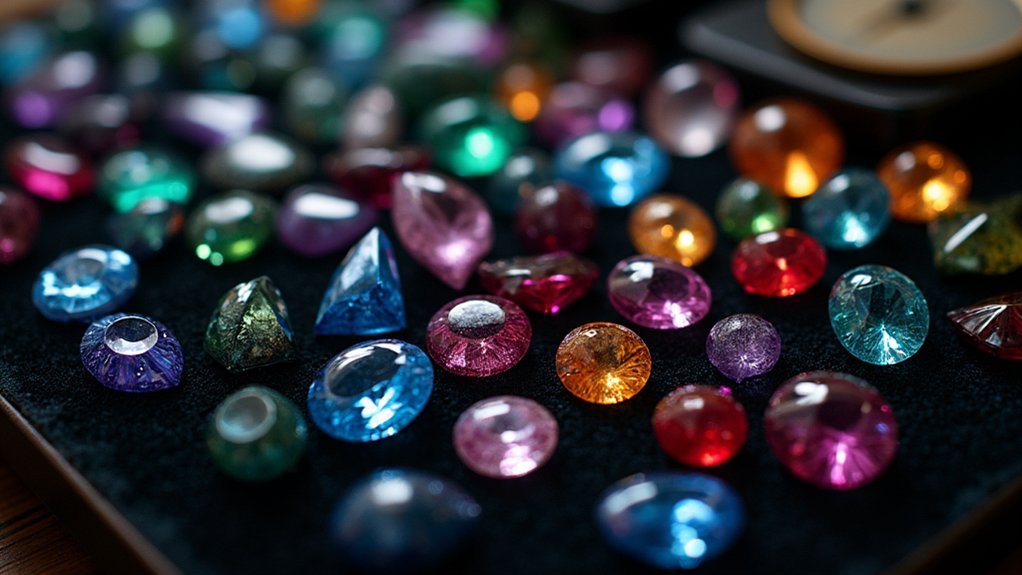



Leave a Reply